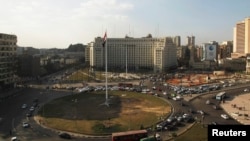A circular patch of land in Cairo's central Tahrir Square poses a dilemma for the government: how to honor the epicenter of the 2011 popular uprising while pressing ahead with one of the fiercest crackdowns on dissent in Egypt's history?
After weeks of digging, workers put up a 20-meter pole carrying the national flag in the space, something officials said they hoped would help to unify a country torn by political turmoil since the revolt that ousted Hosni Mubarak.
It was the latest attempt by authorities to define the narrative in a square where hundreds of thousands of Egyptians staged protests that ended three decades of iron-fisted rule.
"I have not heard any complaints about the flag up to this moment, in spite of the state of uproar in Egypt and the differences of opinions and all the issues. This is good," Cairo Governor Galal Mostafa Saeed told Reuters in an interview.
"It was appropriate for us to put a flag in this place because ... it is unifying and makes people feel nationalistic."
History suggests authorities must proceed cautiously in Tahrir. The former headquarters of Mubarak's ruling party, burned and gutted during the revolt, is nearby on the River Nile, a reminder of the power of the street just four years ago.
In November of 2013, Egyptian activists, who had been keeping a low profile after the army seized power, returned to Tahrir and destroyed a state memorial dedicated to protesters killed by security forces.
They accused the government of trying to paper over past bloodshed and re-write history with a token statue.
This time, officials hope the flag will be a source of pride as the government tries to rebuild an economy hit by political upheaval and Islamist militant violence.
Critics accuse the state of crushing dissent since then-army-chief Abdel Fattah el-Sissi toppled Islamist President Mohamed Morsi in mid-2013 after mass protests against him.
Security forces killed hundreds of Morsi supporters and imprisoned thousands of others. Liberal activists who gained prominence in the 2011 uprising have also been jailed on charges of violating a law that effectively bans demonstrations.
Treading cautiously
The government faces the challenge of persuading Egyptians that it respects the spirit of Tahrir despite widespread condemnation by human rights groups which suggests otherwise.
Workers recently transported the white pole into the square on horsecart and hoisted Egypt's national flag.
So far it has not generated much controversy, or inspiration, reflecting the country's stale politics ahead of a parliamentary election that starts in March.
Some Egyptians view the government's choice with suspicion.
"I think the reason they put up an Egyptian flag is so that if anyone else who wants to protest they'll think twice about pulling down the flag," said Mohamed Nagy, who works at a travel agency overlooking the square. "This is obviously a message to people not to protest."
Tahrir, "liberation", has a history of political struggle dating back to the 1919 against British occupation, giving the square a special status among Egyptians.
Young journalist Mohamad Adam called the flag a "huge joke" and a failed attempt by the government to win over citizens tired of poverty and repression.
Sissi's government wants to revive the confidence of foreign investors and create jobs, with mega-projects such as the building of a second Suez Canal.
But maintaining stability in the most populous Arab state requires more than economic reforms. Discontent emerged in the streets around the anniversary of the 2011 uprising last month.
More than 25 people were killed when security forces quelled protesters angered by what many perceive as a police state.
One day before the anniversary, female protester Shaimaa Sabbagh was shot dead not far from Tahrir. Her colleagues said -- and photographs and video footage showed -- she was shot by police. The Interior Ministry has said they would investigate the death, which was condemned on social media.
"Why should we focus on this flag? It's just a flag. People are dying in protests on the street and they want us to focus on this flag," said bank employee Noha Mohamed, standing in Tahrir.
Urban critics describe the flagpole as proof of state mismanagement of everything from preservation of historic treasures to maintenance of basic infrastructure.
"It shows how impoverished the [government's] ideas are, and how uncaring the state is," said Cairo-based urban studies researcher Sherief Gaber.
"It's a superficial attempt at beautification with neither the kind of thought, effort or money put into it that even superficial beautification requires."
A 28-year-old man named Ahmed said the flag reminded him of his love of Egypt. But he was not encouraged by what it had become since those emotionally-charged days when Mubarak fell.
Just after speaking to a reporter, he was briefly questioned by police about the conversation as a reminder of the growing intolerance even in the heart of Tahrir. Soldiers manned armored vehicles nearby.









